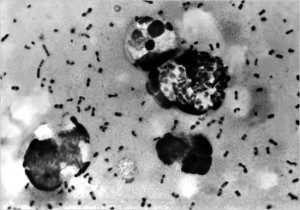 Most microbiologists, epidemiologists and historians agree that the Black Death, the plague that devastated Europe between 1347 and 1353 killing at least a third of the population, was caused by the bacteria Yersinia pestis. Endemic to rodent fleas in China, Y. pestis is thought to have made its way to Europe over the Silk Road and/or sea trade routes.
Most microbiologists, epidemiologists and historians agree that the Black Death, the plague that devastated Europe between 1347 and 1353 killing at least a third of the population, was caused by the bacteria Yersinia pestis. Endemic to rodent fleas in China, Y. pestis is thought to have made its way to Europe over the Silk Road and/or sea trade routes.
There are, however, people who disagree that the Black Death was actually bubonic and pneumonic plague caused by Y. pestis. The primary alternate theory was that it wasn’t a bacterial disease spread by parasites on vermin, but rather an infectious Ebola-like viral hemorrhagic fever that was spread from person to person. The evidence for this was primarily historical — the effectiveness of quarantine, for instance, in stopping the spread of disease.
Now a new study (pdf) from an international team of researchers appears to have conclusively demonstrated that Y. pestis was indeed the cause of the Black Death and all subsequent outbreaks of the plague in Europe. Researchers tested the DNA in tooth pulp recovered from the plague victims buried in plague pits in Hereford, England, Saint-Laurent-de-la-Cabrerisse, France, Bergen op Zoom, the Netherlands, Augsburg, Germany, and Parma, Italy, among others.
They were able to identify the DNA and protein signatures for Y. pestis, and while they were at it, they also discovered two previously unknown clades of the bacterium, both of them ancestors of the Orientalis (the one that devastated India and China in the late 19th century) and Medievalis (the Black Death one) biovars. This suggests that the plague didn’t just come to Europe once over one route. There were at least two distinct pathways Y. pestis took to get to Europe.
Several historical epidemic waves of plague have been attributed to Yersinia pestis, the etiologic agent of modern plague. The most famous of these was the second pandemic which was active in Europe from AD 1347 until 1750, and began with the ‘Black Death’. The most informative method to establish the etiological nature of these ancient infections should be the analysis of ancient DNA, but the results of this method have been controversial. Here, by combining ancient DNA analyses and protein-specific detection, we demonstrate unambiguously that Y. pestis caused the Black Death. Furthermore, we show that at least two variants of Y. pestis spread over Europe during the second pandemic. The analysis of up to 20 diagnostic markers reveals that the two variants evolved near the time that phylogenetic branches 1 and 2 separated and may no longer exist. Our results thus resolve a long-standing debate about the etiology of the Black Death and provide key information about the evolution of the plague bacillus and the spread of the disease during the Middle Ages.
If you’d like to read more about the arguments for and against Y. pestis causation, I highly recommend this excellent series of articles by epidemiologist and Aetiology blogger Tara Smith. They’re from three years ago so they don’t address the recent study, of course, but they’re eminently readable and thoroughly address the issues on all sides.